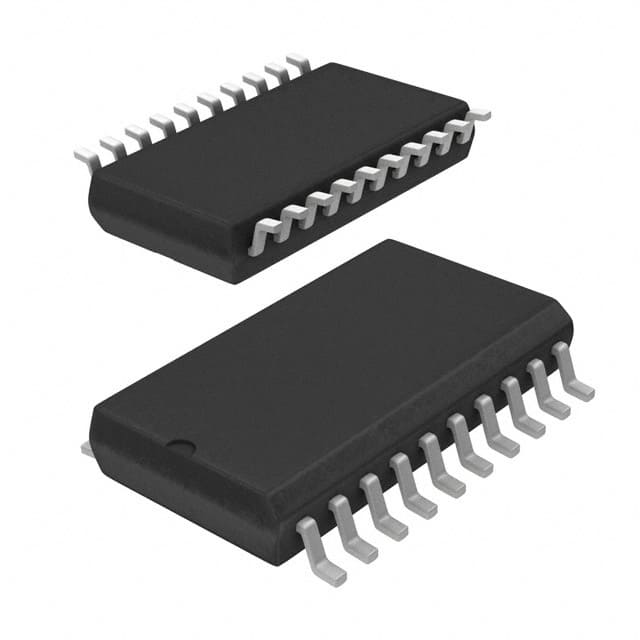Viz Specifikace pro podrobnosti o produktu.

74HC240D-Q100,118
Basic Information Overview
- Category: Integrated Circuit (IC)
- Use: Logic Gate Buffer/Driver
- Characteristics: High-Speed, CMOS Technology
- Package: SOIC (Small Outline Integrated Circuit)
- Essence: Octal Buffer/Line Driver with 3-State Outputs
- Packaging/Quantity: Tape and Reel, 2500 pieces per reel
Specifications
- Supply Voltage Range: 2V to 6V
- Input Voltage Range: 0V to VCC
- Output Voltage Range: 0V to VCC
- Maximum Operating Frequency: 80 MHz
- Number of Inputs: 8
- Number of Outputs: 8
- Output Current: ±6 mA
- Propagation Delay Time: 11 ns (typical)
Detailed Pin Configuration
- GND (Ground)
- A1 (Input A1)
- A2 (Input A2)
- A3 (Input A3)
- A4 (Input A4)
- A5 (Input A5)
- A6 (Input A6)
- A7 (Input A7)
- A8 (Input A8)
- OE (Output Enable)
- Y1 (Output Y1)
- Y2 (Output Y2)
- Y3 (Output Y3)
- Y4 (Output Y4)
- Y5 (Output Y5)
- Y6 (Output Y6)
- Y7 (Output Y7)
- Y8 (Output Y8)
- VCC (Supply Voltage)
Functional Features
- Octal buffer with 3-state outputs
- Non-inverting outputs
- High-speed operation
- Compatible with TTL levels
- Balanced propagation delays
- Wide operating voltage range
- Low power consumption
- ESD protection
Advantages and Disadvantages
Advantages: - High-speed operation allows for efficient data transfer. - Wide operating voltage range provides flexibility in various applications. - Low power consumption helps conserve energy. - ESD protection ensures reliability and durability.
Disadvantages: - Limited output current may restrict certain high-power applications. - Only compatible with TTL levels, not suitable for other logic families. - Propagation delay time may affect timing-sensitive applications.
Working Principles
The 74HC240D-Q100,118 is an octal buffer/line driver IC that amplifies and buffers digital signals. It features non-inverting outputs and 3-state outputs, allowing multiple devices to share a common bus. The inputs are compatible with TTL levels, making it suitable for interfacing between different logic families. The IC operates using CMOS technology, which provides high-speed performance and low power consumption.
Detailed Application Field Plans
- Data communication systems: The 74HC240D-Q100,118 can be used to amplify and buffer data signals in communication networks, ensuring reliable transmission.
- Microcontroller interfacing: It can serve as a level shifter between microcontrollers operating at different voltage levels, enabling seamless communication.
- Memory address decoding: The IC can be utilized to decode memory addresses in computer systems, facilitating efficient access to specific memory locations.
- Bus driving: It can drive buses in multiprocessor systems, allowing multiple devices to communicate and share data efficiently.
Detailed and Complete Alternative Models
- SN74HC240N: Similar octal buffer/line driver IC from Texas Instruments.
- CD74HC240E: Octal buffer/line driver IC from Texas Instruments with similar specifications.
- MC74HC240AN: Octal buffer/line driver IC from ON Semiconductor offering comparable functionality.
(Note: These alternative models are provided as examples and may have slight variations in specifications and pin configuration. It is recommended to refer to the respective datasheets for detailed information.)
This entry provides an overview of the 74HC240D-Q100,118 integrated circuit, including its basic information, specifications, pin configuration, functional features, advantages and disadvantages, working principles, application field plans, and alternative models.
Seznam 10 běžných otázek a odpovědí souvisejících s aplikací 74HC240D-Q100,118 v technických řešeních
Sure! Here are 10 common questions and answers related to the application of 74HC240D-Q100,118:
Q: What is the 74HC240D-Q100,118? A: The 74HC240D-Q100,118 is a high-speed octal buffer/line driver with 3-state outputs.
Q: What is the operating voltage range for the 74HC240D-Q100,118? A: The operating voltage range is typically between 2V and 6V.
Q: What is the maximum output current of the 74HC240D-Q100,118? A: The maximum output current is 35mA per channel.
Q: Can the 74HC240D-Q100,118 be used as an input buffer? A: Yes, it can be used as an input buffer to provide signal conditioning and isolation.
Q: How many inputs and outputs does the 74HC240D-Q100,118 have? A: It has 8 inputs and 8 outputs.
Q: Is the 74HC240D-Q100,118 compatible with TTL logic levels? A: Yes, it is compatible with both CMOS and TTL logic levels.
Q: What is the propagation delay of the 74HC240D-Q100,118? A: The typical propagation delay is around 9 ns.
Q: Can the 74HC240D-Q100,118 be used in high-speed applications? A: Yes, it is designed for high-speed operation and can be used in various applications including data communication and address decoding.
Q: Does the 74HC240D-Q100,118 have built-in ESD protection? A: Yes, it has built-in ESD protection to ensure reliability in harsh environments.
Q: What is the temperature range for the 74HC240D-Q100,118? A: The 74HC240D-Q100,118 is qualified for automotive applications and has a temperature range of -40°C to +125°C.
Please note that these answers are general and may vary depending on the specific datasheet and manufacturer's specifications for the 74HC240D-Q100,118.

